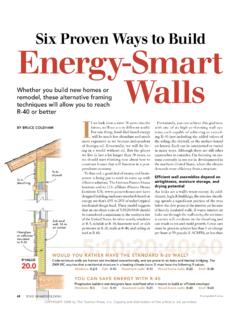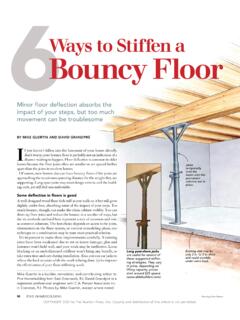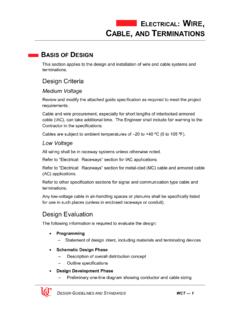Transcription of 9 Common Wiring Mistakes and Code Violations
1 9 Whether to save time or money, lots of nonelectricians do electrical work. This is espe-cially true during the rough-in phase of new construction: drilling holes, running wire, and nailing up boxes . Remod-elers take on tasks as seemingly mundane as installing a new light fixture. As an electrical contractor, I ve hired many union and non-union electricians over the years, and most were horribly misinformed about the elec-trical trade and the building codes. If pro-fessionals have a hard time keeping up with important details, I imagine that carpenters and do-it-yourselfers are going to have a harder time.
2 Before tackling electrical work, you should be aware of a few things. First, check with your local or state build-ing department to see what licenses or per-mits are required. The National Electrical Code dictates minimum requirements for safe electrical installation, but local building authorities often impose their own codes. Second, in some areas, homeowners are not allowed to perform electrical work unless they are licensed or certified electricians. It s a good idea to check with your local or state building authorities before doing any work.
3 In many instances, a homeowner can hire a licensed electrician who can pull a permit and supervise any rough Wiring that the homeowner might do. Potential liabilities are involved (sidebar p. 79), but various resources (p. 80) clearly explain the correct methods Some are illegal, some are dangerous, and some are both but all are simple to avoidBY JOSEPH FRATELLOC ommon Wiring Mistakes and Code ViolationsPROBLEM There must be a 11 4-in. clearance from the edge of a wood-framing member to any wire to keep drywall screws and long trim nails from puncturing the insulation and causing a electricians over the years, and most were horribly misinformed about the elec-If pro-and some are both but all are simple to avoidPROBLEM clearance from the edge of a wood-framing PROBLEMPROBLEM1.
4 Protect Wiring from nails and screws. that make electrical work code-compliant and safe. If you re ready to go to work, keep reading. The following is a list of Mistakes to avoid during electrical installations. Romex needs its jacket wholeOn more than one occasion, I have seen wires punctured by a long fastener that missed its mark. When using nonmetallic sheathed cable (often referred to as Romex), you must maintain a 11 4-in. clearance from the edge of a stud to protect the wire from errant drywall screws or long trim nails.
5 It s hard enough to fix the damage properly, but the risk that the damaged wire could remain unnoticed and start a fire inside the wall cavity is worse. What can you do if you are working on a 2x4 wall and need to bring eight wires into a SOLUTION Wiring passing through holes closer than 11 4 in. to the framing face must be protected with nail plates. Several runs of Wiring can be corralled with inexpensive Cable Stackers, which maintain the distance mandated by I N E H O M E B U I L D I N G76 COPYRIGHT 2007 by The Taunton Press, Inc.
6 Copying and distribution of this article is not boards for the heating and air condi-tioning. Although many people blamed the carpenter for the mishap, the HVAC contrac-tor had violated the code and was responsible for the damage. The HVAC mechanic who ran the wire lost his boxes can start a fireWhen too many wires, outlets, or switches are crammed into a box, the heat generated doesn t have enough airspace to dissipate and in turn can melt wire insulation and has the potential to cause a fire.
7 Box? Cable Stackers, a 3M product ( ), hold up to eight wires and make it easy to position them correctly. In some circumstances, you have no choice but to bore a hole closer than 11 4 in. from a framing edge. There, you must install a steel nail plate, either 1 16 in. thick or UL-listed for that purpose, to protect the wires from damage. Keep low and line voltage apartI often see two-gang boxes installed with a cable or phone jack in one half and a 120v outlet in the other. If an exposed conductor of a low-voltage wire comes in contact with 120v, the higher voltage can damage what-ever is at the end of the low-voltage wire.
8 A solid connection between the exposed low-voltage wire and a 120v wire also can cause the insulation to melt and start a fire. You can t run communication wires (phone, cable, or other low-voltage wires) into a box occupied by 120v or higher unless the communication wire or the box is rated for that use. A similar situation concerns proximity. Phones, cable boxes , computers, and tele-visions all are susceptible to interference, a condition made worse when line voltage and low voltage are run parallel through the same hole.
9 The extent of the interference depends on the quality of wire you use and the amount of current passing through the line-voltage wires. When I run low-voltage wires parallel to line-voltage wires, I fasten the low-voltage wires at least 6 in. away from the line voltage. When you run line- and low-voltage wires in the same hole, you risk having the line voltage cross over into the low volt-age, which can also cause a fire. One unfortunate incident I witnessed could have been easily avoided by keeping the wires separated.
10 A carpenter was adding extra brac-ing for floor joists in the basement of a house we had wired. As he was nailing, he didn t look to see what was on the other side of the joist. He drove a 16d nail straight through a 120v electrical line and into a thermostat wire that the HVAC contractor had run through the same hole after the rough Wiring was complete. When the 120v crossed into the thermostat wire, it destroyed the entire home-automation system, along with all the The problem is made worse when you add dimmers to a crowded switch box.





